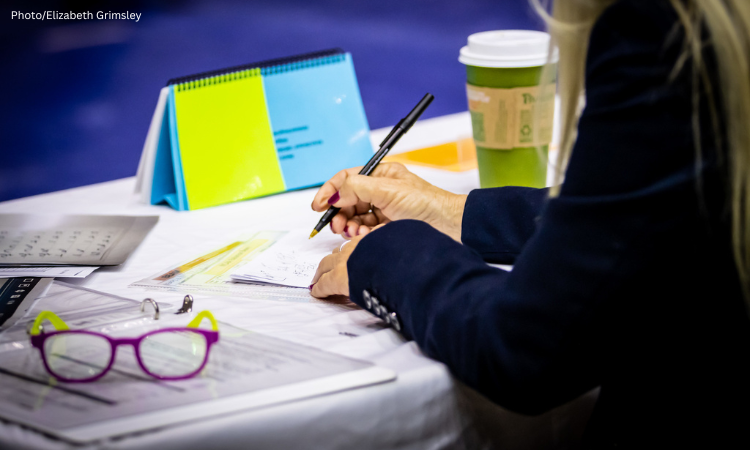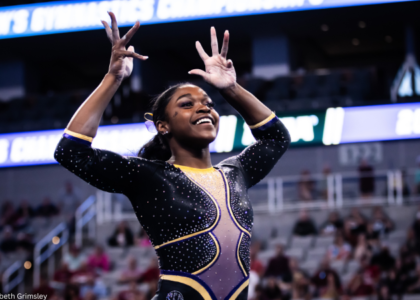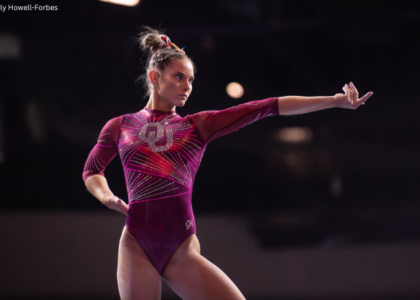What you ever wondered why a routine’s score seems lower than it should and you realize it didn’t start from a 10? Did you wonder why? Or, have you ever wondered what is taking the judges so long?! For any new or confused gymnastics fans that want to better understand how judges come up with their scores, this is for you.
If you’ve ever closely watched a college gymnastics meet, you’ll notice that each judge flashes two scores to each other. One score, the execution score, is averaged between the two judges and becomes the final score. The other usually ranges between a 9.400 and a 10.000. This is the start value, or the maximum score that the athlete can achieve based on the composition of their routine.
If you’re coming to NCAA from the elite gymnastics world, the biggest difference is that the elite system uses an open scoring system, meaning athletes have no maximum start value. The higher the difficulty, the higher the potential score. In NCAA Gymnastics, no athlete can start from above a 10.000, regardless of the amount of difficulty in the routine.
So how do gymnasts earn a 10.0 start value? Each vault is credited with a specific start value, so the judge doesn’t have to calculate anything. Bars, beam and floor have a more complex system to determine the routine’s composition.
Each routine has to have at least eight elements of a minimum difficulty standard: If they are missing elements, they lose one to five tenths from their start value for each omitted element. Usually, this is only a problem if the athlete (for whatever reason) cannot complete their routine.
Next, the judges look at the “special requirements” for each event. This includes things like a minimum number of saltos in a floor routine, leap requirements, bar release requirements, and dismount requirements. If an athlete is missing any of these, it’s two tenths off their start value. If a gymnast has all their special requirements and elements, their start value is a 9.400.
From there, athletes can earn bonus tenths by doing more difficult (D/E level) skills, or skills in combinations with other skills. Athletes can earn up to six tenths in bonus, and they have to have bonus from both connections and difficulty in order to get the full six tenths. If an athlete receives more than six tenths in bonus, it cannot “cancel out” any of the start value deductions for missing skills or special requirements. However, it can make up for missed connections should a gymnast not get credited elsewhere in their routine.
In the rest of this article, I will show you some examples of non 10.000 SV routines and explain how the judges should have calculated the final starting score. For more information about special requirements and bonus, check out the NCAA Rules and Modifications
Bars
Morgan Hurd (Florida): Watch the Routine
✅ Eight elements (3As, 3Bs, 2Cs)
✅ Two bar changes
✅ Two flight elements
✅ Pirouette/release with minimum 180-degree turn
❌ C Dismount: Since Hurd did not attempt a dismount listed in the Code of Points, she loses three tenths from her start value, in addition to not meeting this special requirement.
Bonus Connections
✅ Ray (E) to Pak (D): +0.500
✅ Full pirouette (D): +0.100
Start Value: 9.500
Beam
Sydney Gonzales (Oregon State): Watch the Routine
✅ Eight elements (3As, 3Bs, 2Cs): She does a straddle split mount (not in the video), which is an A. value.
✅ Acro series: Her acro series is a bit slow, but she does not readjust her feet or stop the movement of her arms, so it’s considered connected.
❌ Dance or dance/acro series: The dance element has to be at least a C value. She does a cat leap (A) in her series and an isolated switch leap half (E). (Gonzales later changed this, and now does her cat leap into her switch half, fulfilling the requirement.)
✅ Leap or jump with 180-degree split
✅ Full turn
✅ C dismount
Bonus Connections:
✅ Front aerial (D) to back tuck (C): +0.300
✅ Cat leap (A) to side aerial (D): +0.200
✅ Switch half (E): +0.200
Start Value: 9.800
KJ Johnson (LSU): Watch the Routine
✅ Eight elements (3As, 3Bs, 2Cs)
✅ Acro series
❌/✅ Dance or dance/acro series: Her switch leap connection was questionable. I’d likely give this in real time, but when I watched it a second time, she stops and pumps her arms between the skills, breaking the dance series.
✅ Leap or jump with 180-degree split
✅ Full turn
✅ C dismount
Bonus Connections:
❌/✅ Switch leap (C) to straddle quarter turn (C): +0.200 (If they did not break the connection.)
✅ Back handspring (B) to layout step-out (D): +0.100
❌ Side aerial (D) to sissone (A): +0.100 for the aerial, but she wobbled on the connection, so she does not get the additional tenth for the D+A connection.
✅ Back handspring (B) to back one and a half (C): +0.100
Start Value: 9.500 or 9.900, depending on how strongly the judges felt about the leap connection.
Floor
Lauren Rutherford (N.C. State): Watch the Routine
✅ Eight elements (3As, 3Bs, 2Cs)
✅ Double salto pass: even though she fell, she attempted the front tuck and landed on her feet first, completing the skill, so she gets credit.
✅ Three different saltos
✅ C salto in the last pass
✅ Leap series/pass
Bonus Connections:
✅ Switch half (C) to wolf full (C): +0.100
✅ Back two and a half twist (D): +0.100 to ❌ front tuck (A): She does not receive connection bonus because she fell.
Start Value: 9.600
Emily Wood (Rutgers): Watch the Routine
✅ Eight elements (3As, 3Bs, 2Cs)
✅ Double salto pass
❌ Three different saltos: She was likely supposed to do a front double full at the end, but since she did a second Rudi, she only has two different saltos.
✅ C salto in last pass: She still gets credit for doing the Rudi in her last pass as a D element since the connection is different than the first pass (where she added the back layout). However, she doesn’t get difficulty bonus twice.
✅ Leap series/pass
Bonus Connections:
✅ Front one and a half (Rudi) (D) to back layout step-out (A): +0.300
✅ Tour-jete half (C) to split full (C) to tuck full (B): +0.100
Start Value: 9.600
Julianna Roland (Temple): Watch the Video
✅ Eight elements (3As, 3Bs, 2Cs)
✅ Double salto pass
❌ Three different saltos: New this year, the double salto series must be part of an acrobatic pass, which is “one or more acro elements, one element must be valued at a C or higher.” Since her double salto pass is B+B, this does not meet the standard of an “acro pass,” so she would not meet this requirement.
✅ C salto in last pass
✅ Leap series/pass
Bonus Connections:
✅ Double Pike (D): +0.100
✅ Switch ring leap (C ) to wolf hop full (C ): +0.100 (the turn looked short, but I’ll give it to her.)
✅ Double Tuck (D): +0.200 (You get an extra 0.100 for an E or double-flipping salto as your last pass.)
Of note, you can get a one-tenth bonus for a B+B salto direct connections, but the saltos have to be different. Her front layout to front layout would not qualify for bonus, but it does meet the double salto requirement.
Start Value: 9.6
I hope this helps you appreciate why sometimes the judges can take more time to score routines with falls, broken connections, or surprises. Every routine, the judge has to mentally check each requirement, calculate the bonus, and subtract the execution deductions from the start value, all without the help of slow motion, commentary, video review, or on-screen graphics. Sometimes one judge makes a mistake, which is why judges conference to discuss a routine and correct any errors. If both judges make a mistake, the coach can file an inquiry about the score, which can result in a score change if the judges did indeed miscalculate the score. However, the mistakes that inflate the athlete’s score can sometimes go weeks before a judging panel catches it, and can generate lively discussions among gymnastics fans.
READ THIS NEXT: Judge’s Inquiry: Breaking Down January’s Perfect 10s
Article by Rhiannon Franck
Rhiannon Franck is a former national-rated NAWGJ women’s gymnastics judge with over 15 years of USAG judging experience and nine seasons judging NCAA gymnastics. Outside of gymnastics, Franck works at a university as a nursing professor and loves to travel. You can follow her on Instagram and Twitter.
Like what you see? Consider donating to support our efforts throughout the year!





3 comments